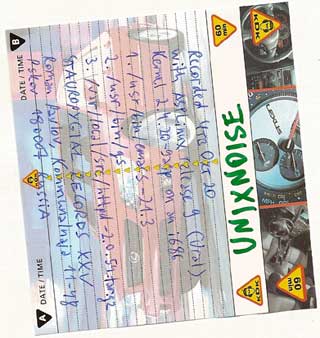XXV UNIXNOISE
tape, hand-made cover. Length: 34 min.
Harsh noise created with standard commands of Linux operating system (and in theory reproducible on other UNIX systems), an amusement, familiar to many console users: any file (or even the contents of RAM) may be copied to the sound input/output device/dev/dsp yielding a horrendous, indescribable noise. The truth is that the aforementioned device accepts interprets input data as a stream in 8 bit mono format, hence the distinctive sound, making some recall ZX Spectrum.
I anticipate being blamed for the name of the project chosen incorrectly: in essence, this kind of sound extraction is not specific to UNIX (and Linux is not UNIX at all, they'll say), but to the OpenSoundSystem architecture, supported at least in older Linuces (cannot tell for sure about modern ones) and in FreeBSD until now. So it would be juster to call it something like OSSNoise. But for the sake of a charismatic and comprehensible name the opinion of purists deserves neglecting, all the more so since right about the time of recording this album I was editing the Russian translation of the book «Advanced Programming in the UNIX environment» by Stephens and Rago, who describe Linux and FreeBSD among typical UNIX systems, so my usage is justified at least by their authority. The site unixpunx.org and the subculture of unixpunks itself also flourished (if we ever may speak of subculture and flourishing in this regard) those days and also used the word UNIX in an ad-hoc meaning of counterculture operating systems and not in the strict sense of a trademark, owned by copyright holders. (The same excuse applies to the song Unixcore by Svinokop, composed by me with even less reason.) One can think of it as of squatting UNIX.
On the tape there are 3 songs, representing sound incarnations of Emacs 21.3 (text editor), gs (PostScript interpreter) and archive of source codes of Apache 2.0.54 (web server). The choice is determined by the predefined length of the tape. In contrast to the digital content (generally unrepresentative for me), the covers were purposely drawn by hand with felt-tip pens. For everything had been recorded directly from the sound card, there were no master audio files as such. Now, after 15 years, I have found those binary files (I hope, the same ones) and attach the reconstruction of the original sound stream to the tape rips.
A review (somewhat naïve) in Russian.
